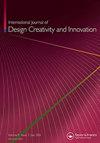从茶点饼干到雨裤:通过使用三个抽象级别的关注点来解决设计难题
IF 2.5
Q4 ENGINEERING, MANUFACTURING
International Journal of Design Creativity and Innovation
Pub Date : 2018-10-02
DOI:10.1080/21650349.2017.1381042
引用次数: 3
摘要
抽象用户经常有相互冲突的担忧(即困境),例如“拥抱变革与遵循传统”设计可以通过同时满足相互冲突的用户关注来解决这些难题。本文提出了三个抽象级别,用于在制定困境时构建用户关注点。在一个大型行业项目中,我们发现困境可以在不同的抽象级别上制定和解决。基于这些初步发现,我们开发了一种结构化的方法来表述困境,包括使用三种不同类型的关注点(即产品、活动和身份关注点)。在这个框架中,以产品为中心的关注表示最具体的关注级别,以身份为中心的关切表示最抽象的级别。60名硕士级设计学生被要求制定一个由他们自己选择的产品引发的困境,并创造设计思想来解决这个困境。结果表明,涉及所有关注水平的困境都可以成为构思的输入,其中“最抽象但信息量最大”的困境最具启发性。此外,我们发现设计可以通过几种不同的方式解决困境,其中每种解决困境的策略都伴随着机遇和挑战。有意识地制定和检查替代困境公式可以创造机会,否则这些机会可能不会被视为构思的输入。本文章由计算机程序翻译,如有差异,请以英文原文为准。
From teatime cookies to rain-pants: resolving dilemmas through design using concerns at three abstraction levels
Abstract Users often have conflicting concerns (i.e., dilemmas), such as ‘embracing change vs. following tradition.’ Design can resolve these dilemmas through simultaneously fulfilling conflicting user concerns. This paper proposes three abstraction levels for framing user concerns when formulating dilemmas. In a large-scale industry project, we identified that dilemmas can be formulated and resolved at different abstraction levels. Based on these preliminary findings, we developed a structured way to formulate dilemmas, which involves using three different types of concerns (i.e., product-, activity-, and identity-focused concerns). In this framework, product-focused concerns represent the most concrete concern level and identity-focused concerns represent the most abstract level. Sixty master-level design students were asked to formulate a dilemma evoked by a product of their own choice and to create design ideas to resolve this dilemma. The results showed that dilemmas involving all concern levels can be an input for ideation, with the ‘most abstract yet informative’ dilemma being the most inspiring. In addition, we found that design can resolve dilemmas in several distinct ways, where each dilemma-resolving strategy comes with opportunities and challenges. Consciously formulating and examining alternative dilemma formulations can create opportunities that might otherwise not be considered as input for ideation.
求助全文
通过发布文献求助,成功后即可免费获取论文全文。
去求助
来源期刊

International Journal of Design Creativity and Innovation
ENGINEERING, MANUFACTURING-
CiteScore
3.80
自引率
27.80%
发文量
15
期刊介绍:
The International Journal of Design Creativity and Innovation is an international publication that provides a forum for discussing the nature and potential of creativity and innovation in design from both theoretical and practical perspectives. Design creativity and innovation is truly an interdisciplinary academic research field that will interest and stimulate researchers of engineering design, industrial design, architecture, art, and similar areas. The journal aims to not only promote existing research disciplines but also pioneer a new one that lies in the intermediate area between the domains of systems engineering, information technology, computer science, social science, artificial intelligence, cognitive science, psychology, philosophy, linguistics, and related fields. The journal covers, but is not restricted to, the following topics: ·Theories on Design Creativity and Innovation ·Cognition of Design Creativity ·Innovative Process ·Inventive Process ·Analogical Reasoning for Design Creativity and Innovation ·Design Synthesis ·Method and Tools for Design Creativity and Innovation ·Representation of Design Creativity and Innovation ·Education for Design Creativity and Innovation ·Concept Generation and Inspiration.
 求助内容:
求助内容: 应助结果提醒方式:
应助结果提醒方式:


